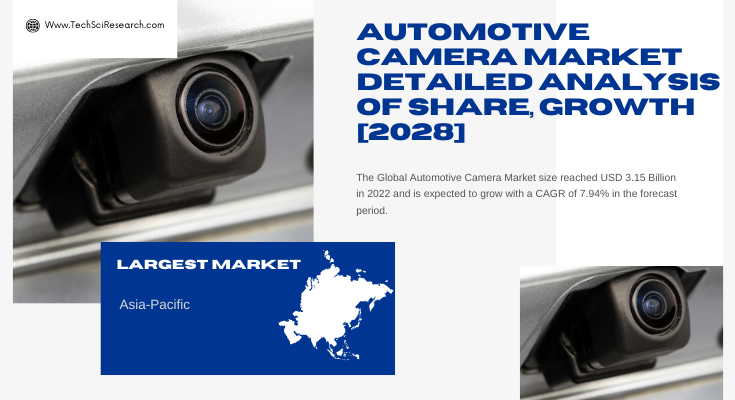According to TechSci Research report, “Automotive Camera Market – Global Industry Size, Share, Trends, Competition Forecast & Opportunities, 2028”, the Global Automotive Camera Market stood at USD 3.15 Billion in 2022 and is anticipated to grow with a CAGR of 7.94% in the forecast period, 2024-2028. The global automotive camera market is experiencing significant growth and is expected to continue expanding in the coming years. Automotive cameras have become an integral part of modern vehicles, playing a crucial role in enhancing safety, improving driver assistance systems, and enabling advanced features such as lane departure warning, adaptive cruise control, and autonomous driving capabilities.
One of the key drivers of the market is the increasing demand for advanced driver assistance systems (ADAS). Governments and regulatory bodies across the globe are implementing stringent safety regulations, mandating the inclusion of ADAS features in vehicles. This has led to a surge in the adoption of automotive cameras as they are essential components for enabling ADAS functionalities. Moreover, the growing trend toward autonomous vehicles is also fueling the demand for automotive cameras. Autonomous vehicles rely heavily on cameras for perception and object detection, allowing them to navigate and make informed decisions in real time. As the development and testing of autonomous vehicles continue to progress, the demand for automotive cameras is expected to witness substantial growth.
Additionally, technological advancements in camera technology are driving market growth. Automotive cameras are becoming more sophisticated, with higher resolutions, improved image quality, and enhanced low-light performance. This enables better object detection, recognition, and tracking, enhancing the overall safety and performance of vehicles. The market is highly competitive, with several key players investing in research and development to introduce innovative camera solutions. Partnerships and collaborations between automotive manufacturers and camera suppliers are also becoming common, further driving market growth. Geographically, the Asia Pacific region is expected to dominate the global automotive camera market. This can be attributed to the presence of major automotive manufacturers in countries like China, Japan, and South Korea, as well as the increasing adoption of ADAS technologies in the region. North America and Europe are also significant markets for automotive cameras, driven by the stringent safety regulations and the presence of key automotive players.
In conclusion, the global automotive camera market is experiencing robust growth due to the increasing demand for ADAS and the rise of autonomous vehicles. Technological advancements and partnerships among industry players are further propelling market expansion.
One significant trend is the integration of multiple cameras in vehicles. Automakers are increasingly incorporating multiple cameras in different positions around the vehicle to provide a comprehensive view of the surroundings. This trend is driven by the need for advanced driver assistance systems (ADAS) and the growing demand for 360-degree surround view systems. By utilizing multiple cameras, vehicles can enhance safety, improve parking assistance, and enable better object detection and recognition.
Another trend is the increasing adoption of high-resolution cameras. As technology advances, automotive cameras are becoming more capable of capturing high-resolution images and videos. Higher resolutions enable better image quality, improved object detection, and enhanced clarity, contributing to the overall effectiveness of ADAS and autonomous driving systems. The demand for high-resolution cameras is driven by the need for more accurate and reliable data for decision-making in real-time.
Furthermore, there is a growing focus on the development of advanced camera technologies, such as infrared (IR) and thermal cameras. These specialized cameras offer unique capabilities for specific applications. Infrared cameras, for example, can detect heat signatures and are used for night vision and pedestrian detection. Thermal cameras can capture images based on heat emissions and are valuable for identifying potential hazards in low-visibility conditions. The integration of these advanced camera technologies expands the capabilities of vehicles and enhances safety in various driving scenarios.
Additionally, there is a rising trend towards the use of artificial intelligence (AI) and machine learning algorithms in automotive cameras. AI algorithms can analyze camera data in real time, enabling advanced functionalities such as object recognition, pedestrian detection, and traffic sign recognition. The use of AI in automotive cameras enhances the accuracy and reliability of the camera system, contributing to improved safety and autonomous driving capabilities. The market is also witnessing a shift towards the development of compact and miniaturized camera modules. As vehicles become more streamlined and aerodynamic, there is a need for smaller and more discreet camera designs. Compact camera modules offer flexibility in installation and can be seamlessly integrated into the vehicle’s design without compromising aesthetics.
Furthermore, there is a growing emphasis on cybersecurity in automotive cameras. With the increasing connectivity of vehicles, there is a need to ensure the security and integrity of camera systems. Manufacturers are implementing robust cybersecurity measures to protect against potential threats and unauthorized access to camera data.
Overall, the global automotive camera market is experiencing trends such as the integration of multiple cameras, the adoption of high-resolution cameras, the development of advanced camera technologies, the use of AI and machine learning, the focus on compact camera modules, and the emphasis on cybersecurity. These trends are driving innovation and shaping the future of automotive camera systems.
Browse over XX market data Figures spread through XX Pages and an in-depth TOC on the ” Global Automotive Camera Market” @ https://www.techsciresearch.com/report/automotive-camera-market/12870.html
The North American region holds a significant share in the global automotive camera market. The region is home to major automotive manufacturers and has a well-established automotive industry. The demand for automotive cameras in North America is driven by factors such as stringent safety regulations, increasing consumer awareness about driver assistance systems, and the growing adoption of advanced technologies in vehicles. The United States, in particular, is a key market for automotive cameras, with a high demand for ADAS features and a strong focus on vehicle safety.
Europe: Europe is another prominent region in the global automotive camera market. The region is known for its strong automotive industry and stringent safety standards. European countries have been early adopters of ADAS technologies, driving the demand for automotive cameras. Additionally, the European Union’s regulations mandating the inclusion of advanced safety features in vehicles further contribute to the growth of the automotive camera market in the region. Germany, France, and the United Kingdom are the major contributors to the European market.
Asia Pacific: The Asia Pacific region is witnessing significant growth in the automotive camera market. The region is home to some of the largest automotive markets, including China, Japan, and South Korea. The increasing vehicle production, rising disposable income, and growing awareness about vehicle safety are driving the demand for automotive cameras in the region. Moreover, the adoption of ADAS technologies and the push towards autonomous driving further fuel the market growth in Asia Pacific. Latin America is an emerging market for automotive cameras. The region is experiencing a gradual increase in vehicle production and consumer demand for advanced safety features. Countries like Brazil and Mexico are witnessing growth in the automotive industry, which in turn drives the demand for automotive cameras. The implementation of safety regulations and the focus on reducing road accidents also contribute to the market growth in this region.
Middle East and Africa: The Middle East and Africa region have a growing automotive industry, driven by factors such as urbanization, economic development, and increasing consumer purchasing power. The demand for automotive cameras in this region is primarily driven by the need for improved safety and the adoption of advanced technologies. Countries like Saudi Arabia, South Africa, and the United Arab Emirates are the key contributors to the automotive camera market in the Middle East and Africa.
Major companies operating in the Global Automotive Camera Market are:
- ADA-ES Inc.
- Allied Vision Technologies
- Ballif
- Basler AG
- Autoliv, Inc
- Delphi Automotive PLC
- Denso Corporation
- Robert Bosch GmBH
- Valeo S.A.
- TRW Automotive
Download Free Sample Report @ https://www.techsciresearch.com/sample-report.aspx?cid=12870
Customers can also request 10% free customization in this report
“The global automotive camera market is poised for significant growth in the coming years. Factors such as increasing vehicle safety regulations, the growing demand for advanced driver assistance systems (ADAS), and the rise of autonomous driving technologies are driving the market. Additionally, the integration of multiple cameras, the development of high-resolution imaging capabilities, and the adoption of artificial intelligence (AI) algorithms are further fueling the growth of the automotive camera market,” said Mr. Karan Chechi, Research Director with TechSci Research, a research-based management consulting firm.
“Automotive Camera Market – Global Industry Size, Share, Trends Opportunity, and Forecast, Segmented By Camera Type (Infrared, Thermal and Digital), By Application Type (Lane Departure Warning, Adaptive Cruise Control, Blind Spot Detection, Park Assist System), By Vehicle Type (Passenger Cars, Light Commercial Vehicles, Heavy Commercial Vehicles, and Two Wheelers), By Region, Competition, 2018-2028”, has evaluated the future growth potential of Global Automotive Camera Market and provides statistics & information on market size, structure, and future market growth. The report intends to provide cutting-edge market intelligence and help decision-makers take sound investment decisions. Besides, the report also identifies and analyzes the emerging trends along with essential drivers, challenges, and opportunities in the Global Automotive Camera Market.
You may also read:
Automotive Plastic Fasteners Market – Current Analysis and Forecast [2028]
Competitive Landscape and Innovation in North America Automotive Heat Shield Market
Automotive Vehicle-To-Everything Market [ Latest] Report by Analysis, Share, Leaders
E-Commerce Automotive AfterMarket Industry [2028]- Exploring Robust Growth & Forecast
Rising Demand and Growth Trends– North America Automotive Air Filters Market
Table of Content-Automotive Camera Market
- Introduction
1.1. Product Overview
1.2. Key Highlights of the Report
1.3. Market Coverage
1.4. Market Segments Covered
1.5. Research Tenure Considered
- Research Methodology
2.1. Objective of the Study
2.2. Baseline Methodology
2.3. Key Industry Partners
2.4. Major Association and Secondary Sources
2.5. Forecasting Methodology
2.6. Data Triangulation & Validation
2.7. Assumptions and Limitations
- Executive Summary
3.1. Market Overview
3.2. Market Forecast
3.3. Key Regions
3.4. Key Segments
- Impact of COVID-19 on Global Automotive Camera Market
- Global Automotive Camera Market Outlook
5.1. Market Size & Forecast
5.1.1. By Value & Volume
5.2. Market Share & Forecast
5.2.1. By Camera Type Market Share Analysis (Infrared, Thermal and Digital)
5.2.2. By Application Type Market Share Analysis (Lane Departure Warning, Adaptive Cruise Control, Blind Spot Detection, Park Assist System)
5.2.3. By Vehicle Type Market Share Analysis (Passenger Cars, Light Commercial Vehicles, Heavy Commercial Vehicle, and Two-Wheelers)
5.2.4. By Regional Market Share Analysis
5.2.4.1. Asia-Pacific Market Share Analysis
5.2.4.2. Europe & CIS Market Share Analysis
5.2.4.3. North America Market Share Analysis
5.2.4.4. South America Market Share Analysis
5.2.4.5. Middle East & Africa Market Share Analysis
5.2.5. By Company Market Share Analysis (Top 5 Companies, Others – By Value, 2022)
5.3. Global Automotive Camera Market Mapping & Opportunity Assessment
5.3.1. By Camera Type Market Mapping & Opportunity Assessment
5.3.2. By Application Type Market Mapping & Opportunity Assessment
5.3.3. By Vehicle Type Market Mapping & Opportunity Assessment
5.3.4. By Regional Market Mapping & Opportunity Assessment
- Asia-Pacific Automotive Camera Market Outlook
6.1. Market Size & Forecast
6.1.1. By Value & Volume
6.2. Market Share & Forecast
6.2.1. By Camera Type Market Share Analysis
6.2.2. By Application Type Market Share Analysis
6.2.3. By Vehicle Type Market Share Analysis
6.2.4. By Country Market Share Analysis
6.2.4.1. China Market Share Analysis
6.2.4.2. India Market Share Analysis
6.2.4.3. Japan Market Share Analysis
6.2.4.4. Indonesia Market Share Analysis
6.2.4.5. Thailand Market Share Analysis
6.2.4.6. South Korea Market Share Analysis
6.2.4.7. Australia Market Share Analysis
6.2.4.8. Rest of Asia-Pacific Market Share Analysis




